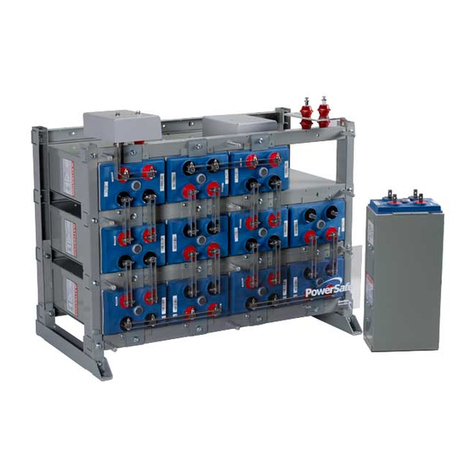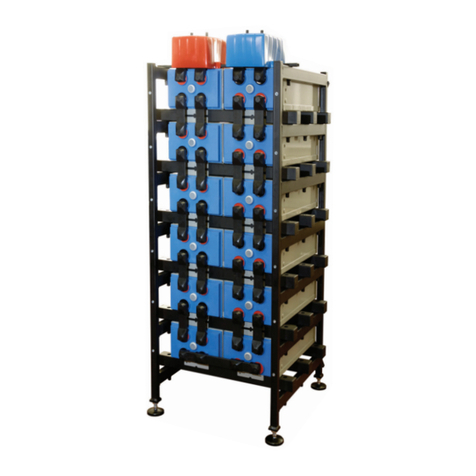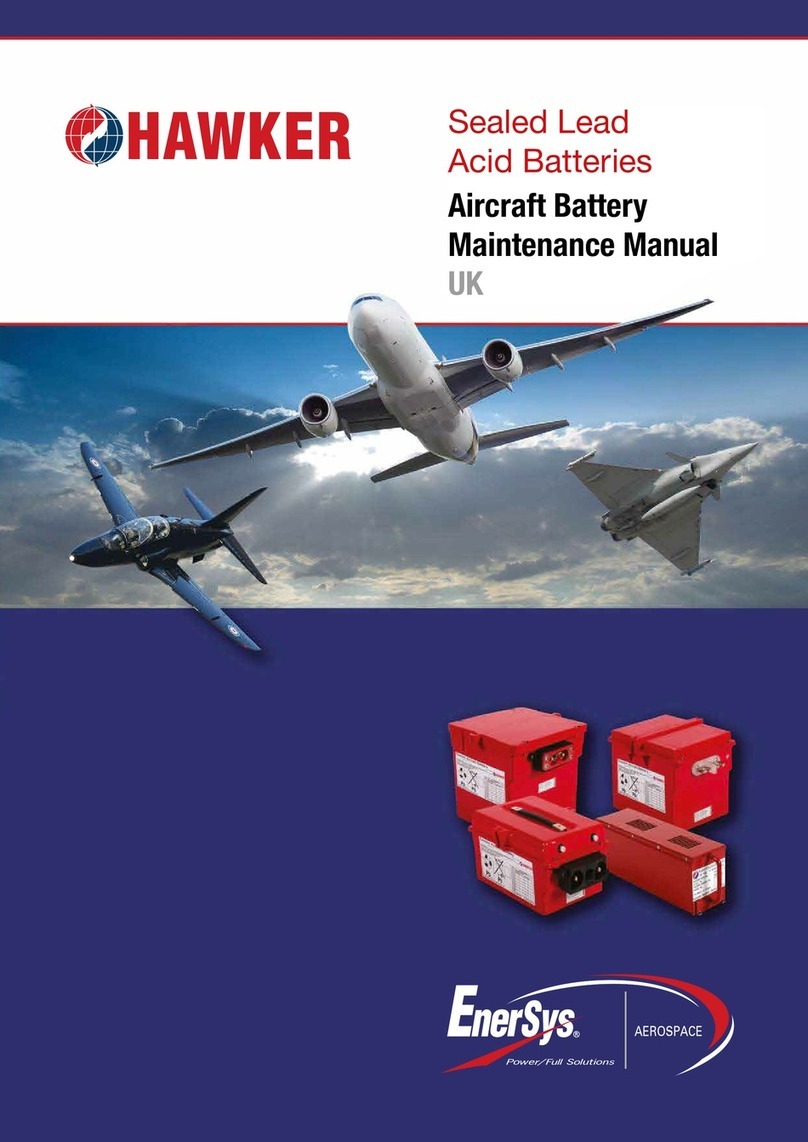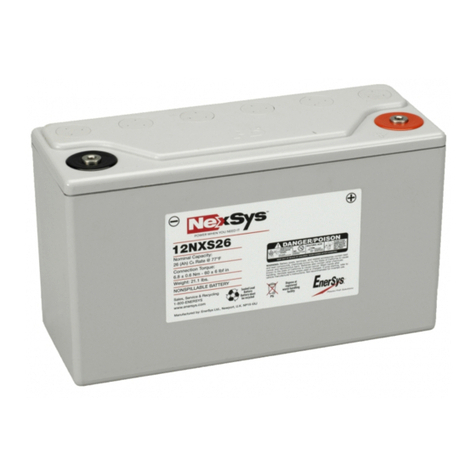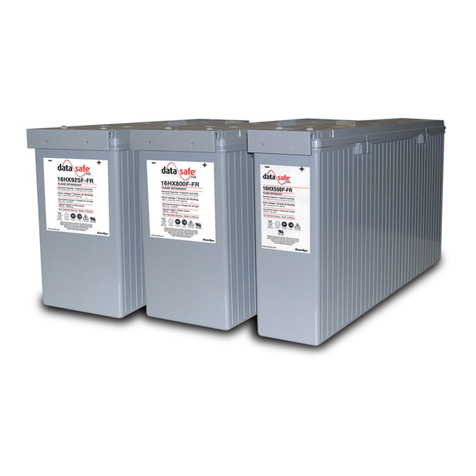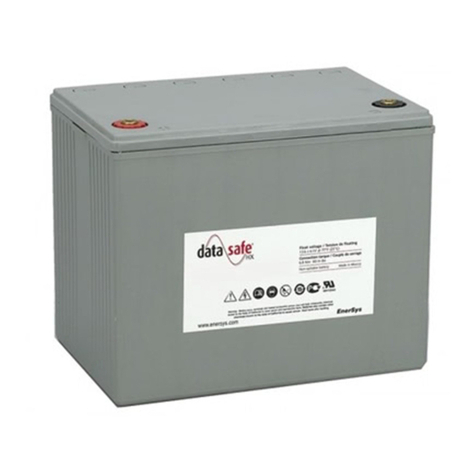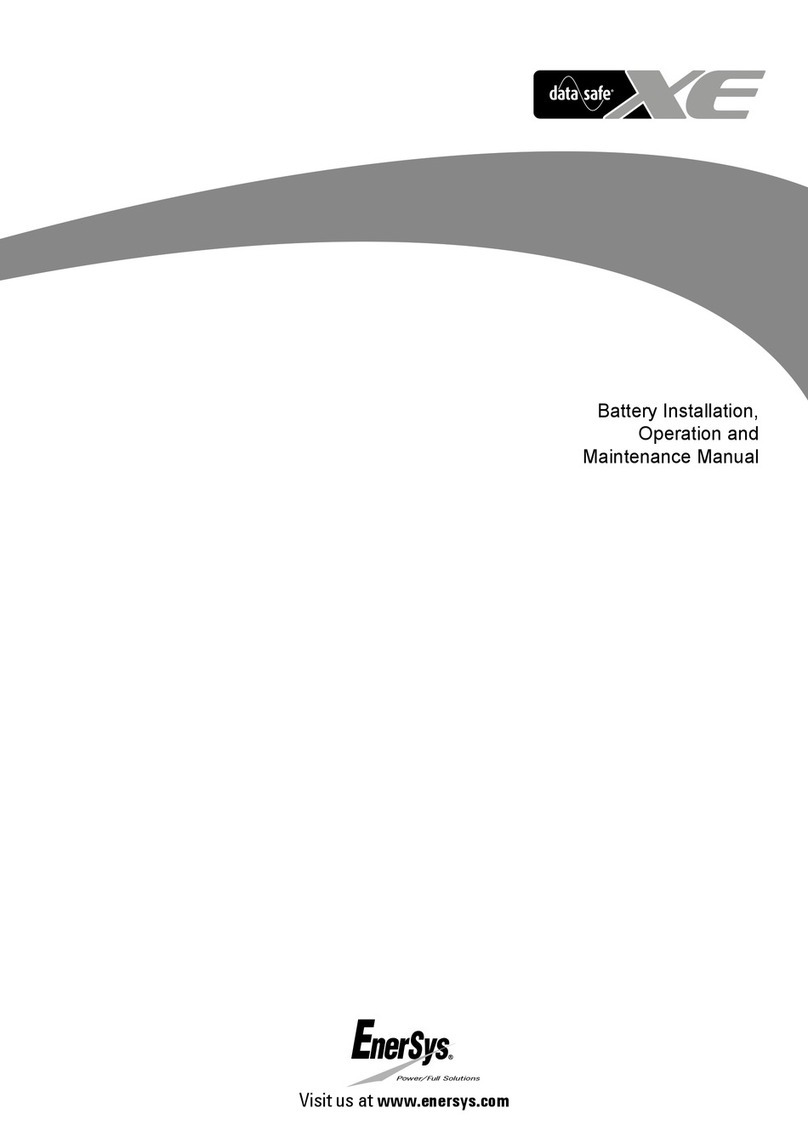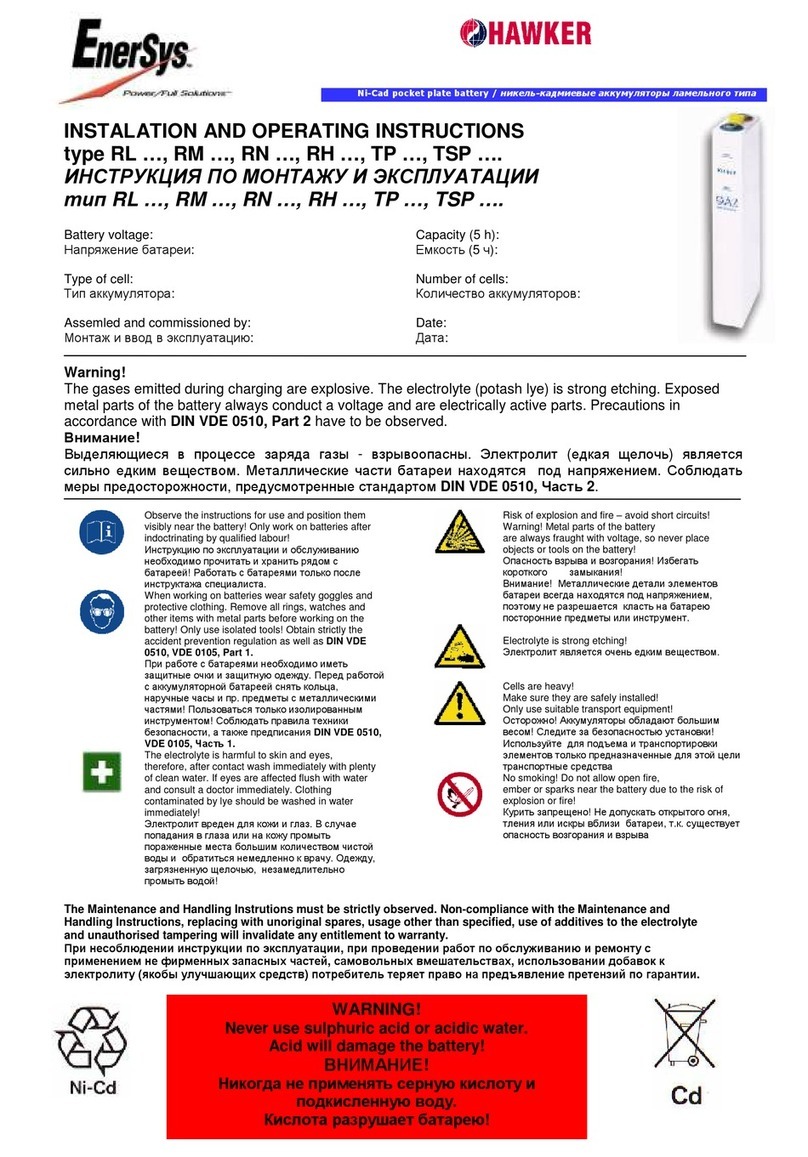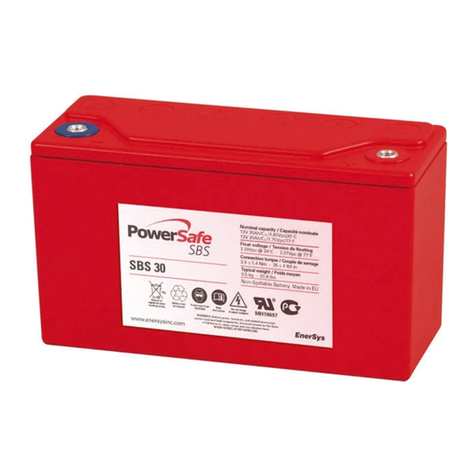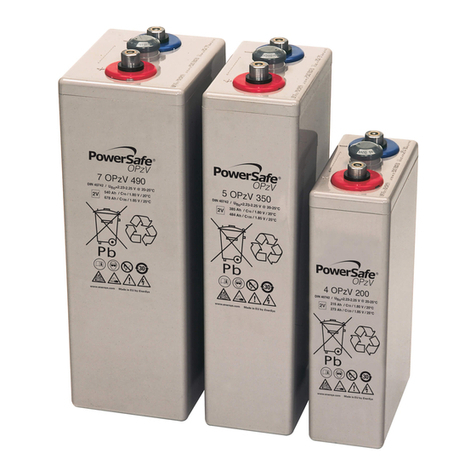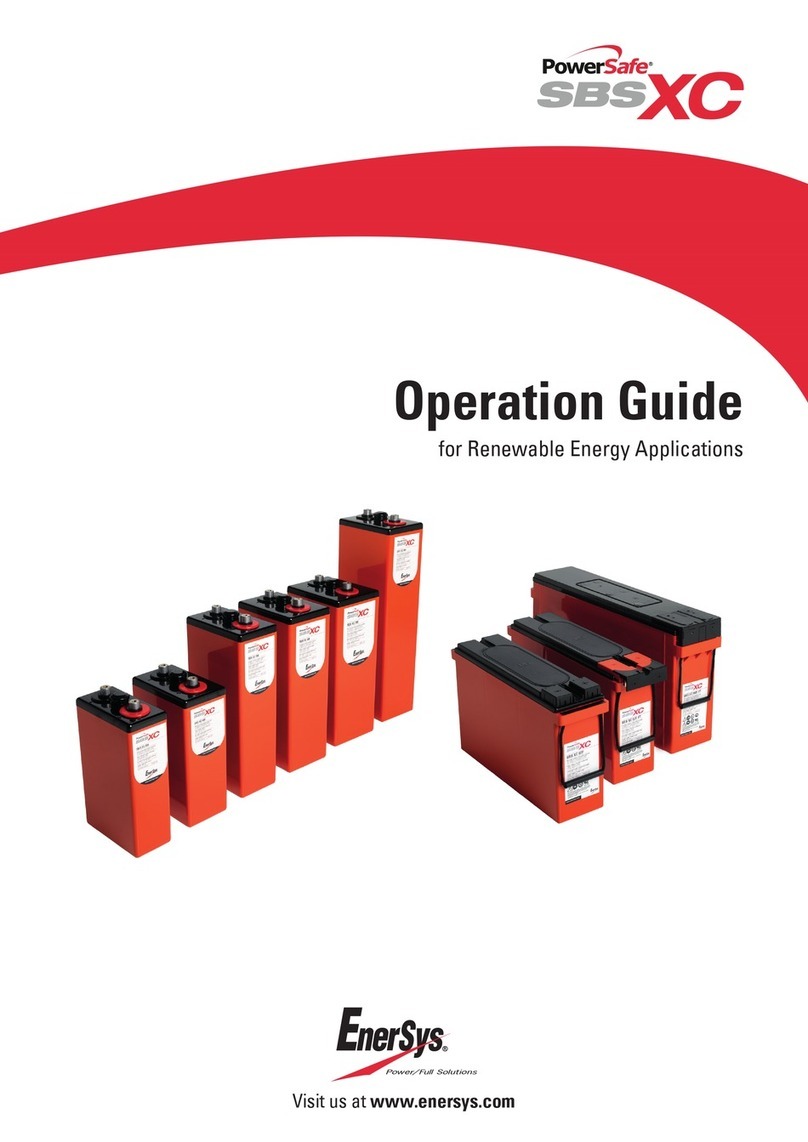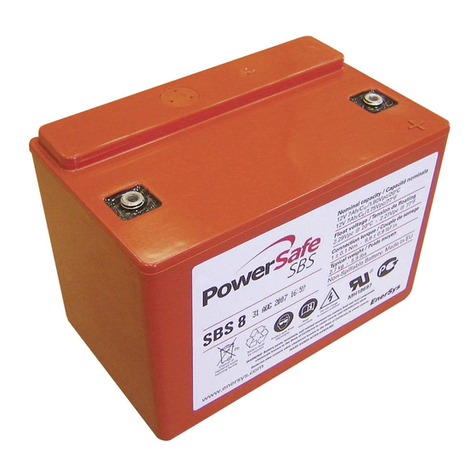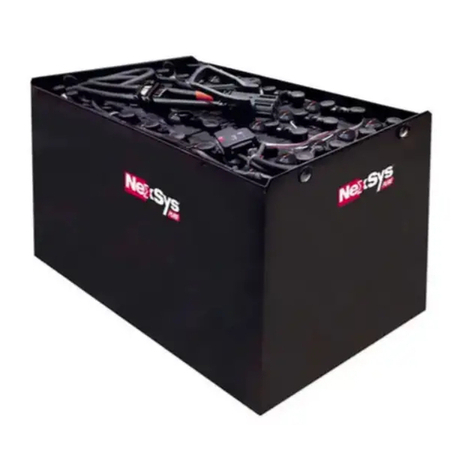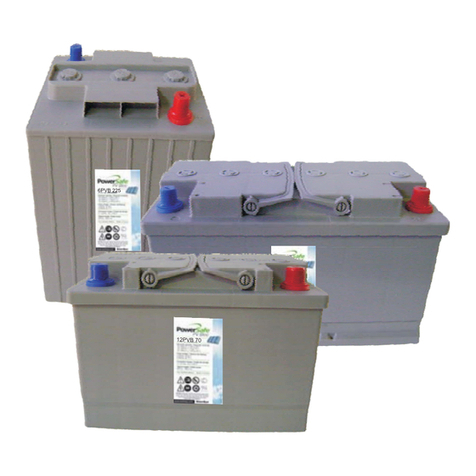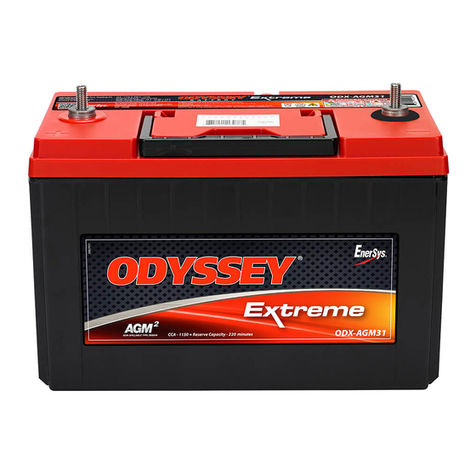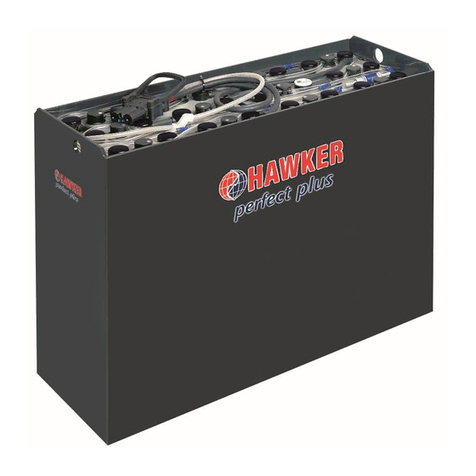
1. Receiving
1.1. In-Tr ansit Damage or Short Shipments
Upon receipt of the shipment, check the contents for damage and
completeness against the packing slip. Immediately inform EnerSys®of
any damaged or missing items. EnerSys is not responsible for shipment
damage or shortages that the receiver does not report to the carrier.
1.2. Shipment Damage or Shortages
Open the shipping containers and check the contents for damage and
against the packing slip. Immediately inform EnerSys of any damaged or
missing items. EnerSys is not responsible for damaged or missing items
after a shipment has been in storage.
2. Storage
2.1. Storage Conditions and Time
If a battery cannot be installed immediately, it should be stored in a
clean, cool and dry area. During storage monoblocs lose capacity
through self-discharge. High temperatures increase the rate of self-
discharge and reduce the storage life.
The chart below shows the relationship between open-circuit voltage
(OCV) and storage time at various temperatures.
2
Handling
DataSafe®XE batteries are supplied in a charged
condition and are capable of extremely high short
circuit currents. Take care to avoid short-circuiting
terminals of opposite polarity.
California Proposition 65 Warning - Battery posts, terminals, and related accessories contain lead and lead compounds, chemicals known to the State of California to
cause cancer and reproductive harm. Wash hands after handling.
Care for your safety
Keep flames away
Discharge any possible static electricity from clothes
by touching an earth connected part.
Tools
Use tools with insulated handles.
Do not place or drop metal objects on the battery.
Remove rings, wristwatch and articles of clothing
with metal parts that may come into contact with
the battery terminals.
No smoking, no naked flames, no
sparks
Shield eyes Read instructions
Electrical hazard Danger Re-cycle scrap batteries.
Contains lead
Electrolyte is corrosive
Clean all acid splash in eyes or on skin
with plenty of clean water.
Then seek medical help.
Acid on clothing is to be washed with
water
Warning: Risk of fire, explosion, or
burns. Do not disassemble, heat above
60ºC, or incinerate. Avoid any short
circuit. Metallic parts under voltage on
the battery, do not place tools or items
on top of the battery
Monoblocs must be given a refresh charge when bloc voltages
approach the equivalent of 2.10 Volts per cell or when the maximum
storage time is reached, whichever occurs first.
2.2. Refresh Charge
Charge the monoblocs or strings at a constant voltage equivalent to
2.29 - 2.40Vpc with 0.1C10 current available for a period of 24 hours.
2.3. Commissioning Charge
Before commencing operation, the battery must be given a
commissioning charge.
•The batteries should be charged using constant voltage
with a minimum charge current of 0.1C10 with no load
connected to the battery.
•Charge for 48 hours at the charge voltage of 2.30Vpc at
20ºC/68ºF to 25ºC/77ºF.
The maximum storage times before a refresh charge is required
and recommended open circuit voltage audit intervals are:
Temperature Storage Time OCV Audit
(°C / °F) (Months) Intervals (Months)
+10 / +50 48 12
+15 / +59 34 12
+20 / +68 24 12
+25 / +77 17 6
+30 / +86 12 6
+35 /+95 8.5 3
+40 /+104 6 3
Open Circuit Voltage per Cell
Months
Approx. % State of Charge
2.17
2.16
2.15
2.14
2.13
2.12
2.11
2.10
100
96
91
87
83
79
74
70
0 6 12 18 24 30 36 42 48
Important
Please read this manual immediately on receipt of the battery before unpacking and installing. Failure to comply with these instructions
will render any warranties null and void.
Handling
DataSafe®HX+batteries are supplied in
a charged condition and are capable of
extremely high short circuit currents. Take
care to avoid short-circuiting terminals of
opposite polarity.
Use caution when handling and moving
batteries. Appropriate lifting equipment must
be used.
Care for your safety
Keep flames away
In case of accidental overcharge
a flammable gas can leak off the
safety vent.
Discharge any possible static
electricity from clothes by touching
an earth connected part.
Tools
Use tools with insulated handles.
Do not place or drop metal objects on the
battery.
Remove rings, wristwatch and articles of
clothing with metal parts that may come into
contact with the battery terminals.
Handling
DataSafe®XE batteries are supplied in a charged
condition and are capable of extremely high short
circuit currents. Take care to avoid short-circuiting
terminals of opposite polarity.
California Proposition 65 Warning - Battery posts, terminals, and related accessories contain lead and lead compounds, chemicals known to the State of California to
cause cancer and reproductive harm. Wash hands after handling.
Care for your safety
Keep flames away
Discharge any possible static electricity from clothes
by touching an earth connected part.
Tools
Use tools with insulated handles.
Do not place or drop metal objects on the battery.
Remove rings, wristwatch and articles of clothing
with metal parts that may come into contact with
the battery terminals.
No smoking, no naked flames, no
sparks
Shield eyes Read instructions
Electrical hazard Danger Re-cycle scrap batteries.
Contains lead
Electrolyte is corrosive
Clean all acid splash in eyes or on skin
with plenty of clean water.
Then seek medical help.
Acid on clothing is to be washed with
water
Warning: Risk of fire, explosion, or
burns. Do not disassemble, heat above
60ºC, or incinerate. Avoid any short
circuit. Metallic parts under voltage on
the battery, do not place tools or items
on top of the battery
Handling
DataSafe®XE batteries are supplied in a charged
condition and are capable of extremely high short
circuit currents. Take care to avoid short-circuiting
terminals of opposite polarity.
California Proposition 65 Warning - Battery posts, terminals, and related accessories contain lead and lead compounds, chemicals known to the State of California to
cause cancer and reproductive harm. Wash hands after handling.
Care for your safety
Keep flames away
Discharge any possible static electricity from clothes
by touching an earth connected part.
Tools
Use tools with insulated handles.
Do not place or drop metal objects on the battery.
Remove rings, wristwatch and articles of clothing
with metal parts that may come into contact with
the battery terminals.
No smoking, no naked flames, no
sparks
Shield eyes Read instructions
Electrical hazard Danger Re-cycle scrap batteries.
Contains lead
Electrolyte is corrosive
Clean all acid splash in eyes or on skin
with plenty of clean water.
Then seek medical help.
Acid on clothing is to be washed with
water
Warning: Risk of fire, explosion, or
burns. Do not disassemble, heat above
60ºC, or incinerate. Avoid any short
circuit. Metallic parts under voltage on
the battery, do not place tools or items
on top of the battery
Handling
DataSafe®XE batteries are supplied in a charged
condition and are capable of extremely high short
circuit currents. Take care to avoid short-circuiting
terminals of opposite polarity.
California Proposition 65 Warning - Battery posts, terminals, and related accessories contain lead and lead compounds, chemicals known to the State of California to
cause cancer and reproductive harm. Wash hands after handling.
Care for your safety
Keep flames away
Discharge any possible static electricity from clothes
by touching an earth connected part.
Tools
Use tools with insulated handles.
Do not place or drop metal objects on the battery.
Remove rings, wristwatch and articles of clothing
with metal parts that may come into contact with
the battery terminals.
No smoking, no naked flames, no
sparks
Shield eyes Read instructions
Electrical hazard Danger Re-cycle scrap batteries.
Contains lead
Electrolyte is corrosive
Clean all acid splash in eyes or on skin
with plenty of clean water.
Then seek medical help.
Acid on clothing is to be washed with
water
Warning: Risk of fire, explosion, or
burns. Do not disassemble, heat above
60ºC, or incinerate. Avoid any short
circuit. Metallic parts under voltage on
the battery, do not place tools or items
on top of the battery
Handling
DataSafe®XE batteries are supplied in a charged
condition and are capable of extremely high short
circuit currents. Take care to avoid short-circuiting
terminals of opposite polarity.
California Proposition 65 Warning - Battery posts, terminals, and related accessories contain lead and lead compounds, chemicals known to the State of California to
cause cancer and reproductive harm. Wash hands after handling.
Care for your safety
Keep flames away
Discharge any possible static electricity from clothes
by touching an earth connected part.
Tools
Use tools with insulated handles.
Do not place or drop metal objects on the battery.
Remove rings, wristwatch and articles of clothing
with metal parts that may come into contact with
the battery terminals.
No smoking, no naked flames, no
sparks
Shield eyes Read instructions
Electrical hazard Danger Re-cycle scrap batteries.
Contains lead
Electrolyte is corrosive
Clean all acid splash in eyes or on skin
with plenty of clean water.
Then seek medical help.
Acid on clothing is to be washed with
water
Warning: Risk of fire, explosion, or
burns. Do not disassemble, heat above
60ºC, or incinerate. Avoid any short
circuit. Metallic parts under voltage on
the battery, do not place tools or items
on top of the battery
Handling
DataSafe®XE batteries are supplied in a charged
condition and are capable of extremely high short
circuit currents. Take care to avoid short-circuiting
terminals of opposite polarity.
California Proposition 65 Warning - Battery posts, terminals, and related accessories contain lead and lead compounds, chemicals known to the State of California to
cause cancer and reproductive harm. Wash hands after handling.
Care for your safety
Keep flames away
Discharge any possible static electricity from clothes
by touching an earth connected part.
Tools
Use tools with insulated handles.
Do not place or drop metal objects on the battery.
Remove rings, wristwatch and articles of clothing
with metal parts that may come into contact with
the battery terminals.
No smoking, no naked flames, no
sparks
Shield eyes Read instructions
Electrical hazard Danger Re-cycle scrap batteries.
Contains lead
Electrolyte is corrosive
Clean all acid splash in eyes or on skin
with plenty of clean water.
Then seek medical help.
Acid on clothing is to be washed with
water
Warning: Risk of fire, explosion, or
burns. Do not disassemble, heat above
60ºC, or incinerate. Avoid any short
circuit. Metallic parts under voltage on
the battery, do not place tools or items
on top of the battery
Handling
DataSafe®XE batteries are supplied in a charged
condition and are capable of extremely high short
circuit currents. Take care to avoid short-circuiting
terminals of opposite polarity.
California Proposition 65 Warning - Battery posts, terminals, and related accessories contain lead and lead compounds, chemicals known to the State of California to
cause cancer and reproductive harm. Wash hands after handling.
Care for your safety
Keep flames away
Discharge any possible static electricity from clothes
by touching an earth connected part.
Tools
Use tools with insulated handles.
Do not place or drop metal objects on the battery.
Remove rings, wristwatch and articles of clothing
with metal parts that may come into contact with
the battery terminals.
No smoking, no naked flames, no
sparks
Shield eyes Read instructions
Electrical hazard Danger Re-cycle scrap batteries.
Contains lead
Electrolyte is corrosive
Clean all acid splash in eyes or on skin
with plenty of clean water.
Then seek medical help.
Acid on clothing is to be washed with
water
Warning: Risk of fire, explosion, or
burns. Do not disassemble, heat above
60ºC, or incinerate. Avoid any short
circuit. Metallic parts under voltage on
the battery, do not place tools or items
on top of the battery
Read instructions
Shield eyes
Clean all acid splash in
eyes or on skin with plenty
of clean water.
Then seek medical help.
Acid on clothing is to be
washed with water
Warning: Risk of fire, explosion,
or burns. Do not disassemble,
heat above 60°C, or incinerate.
Avoid any short circuit. Metallic
parts under voltage on the
battery, do not place tools or
items on top of the battery
Electrolyte is highly
corrosive!
Danger
No smoking, no naked
flames, no sparks
Pb
Electrical hazard Re-cycle scrap batteries.
Contains lead
California Proposition 65 Warning - Battery posts, terminals, and related accessories contain lead and lead compounds, chemicals known
to the State of California to cause cancer and reproductive harm. Wash hands after handling.





